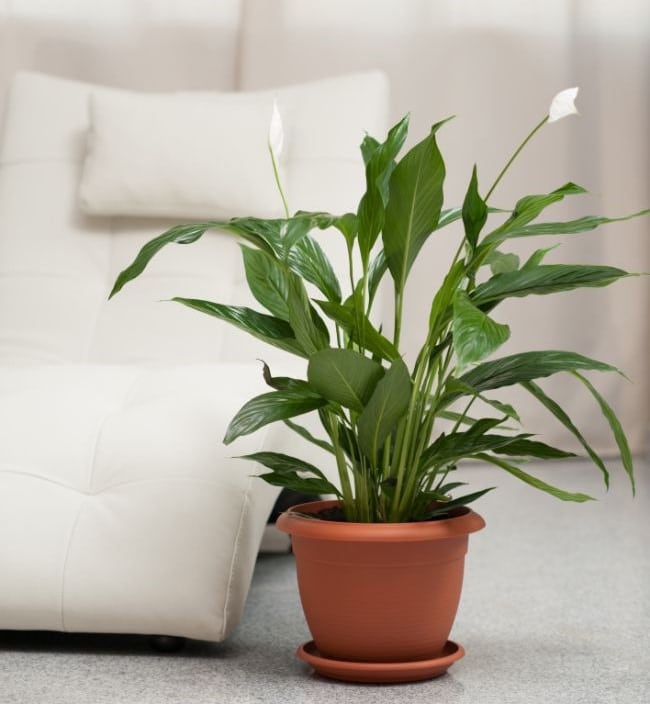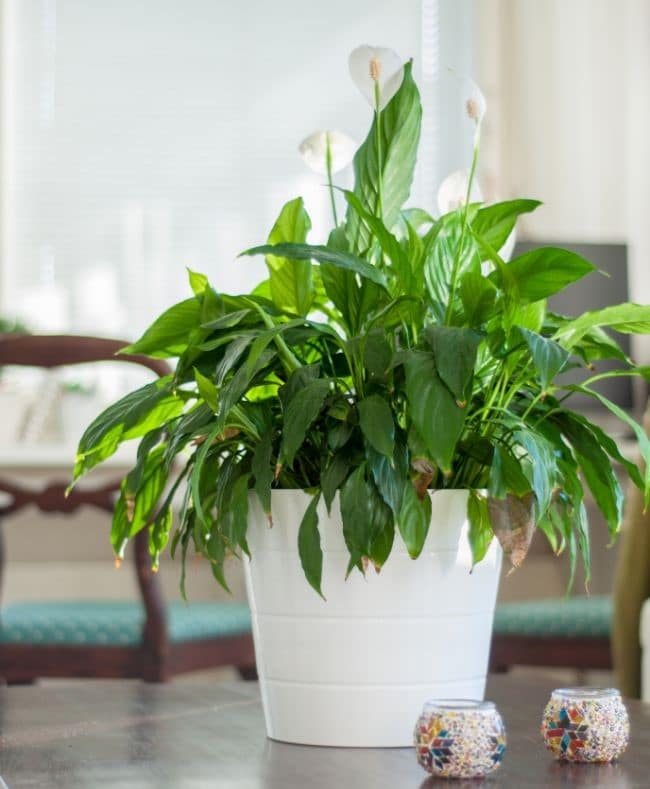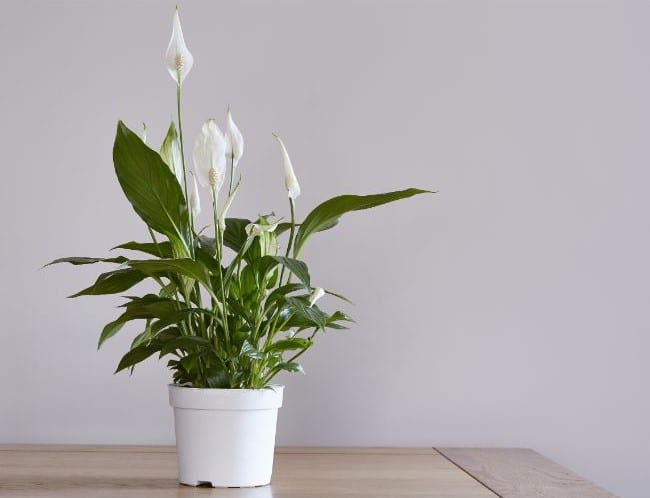If you are looking to water peace lilies the right way, you’ve come to the right place. Watering problems are common and can really impact the health of your plant. By following the tips in this article, you’ll be well on your way to knowing how to water peace lilies correctly.
How to water peace lilies: Peace lilies should be watered once the top half of the potting soil is dry, but before the leaves begin to droop. Water thoroughly until water runs out the drainage holes. Use well-draining potting soil and avoid letting the plant sit in water, as this will lead to root rot.
Watering peace lilies is one of the most important aspects of care, but it’s also one of the most common causes of problems. Read on and I’ll show you the things that really matter.
How To Water Peace Lilies
There are three things that are really important to get right when watering peace lilies. Get these right, and you’ll be well on your way to providing excellent care.
1. Quantity Of Water
Water your peace lily thoroughly once the top half of the potting soil is dry. Watering thoroughly has a number of benefits that can make a real difference to the health of your peace lily.
Firstly, it prevents the build-up of fertilizer salts in the potting mix by flushing them out of the soil. Excess fertilizer salts in the soil will cause brown tips to develop and can cause other symptoms of nutrient toxicity that are really damaging to your plant over time.
Secondly, soaking your peace lily ensures that you don’t accidentally underwater your plant. You see, potting soil acts very much like a sponge. You may have noticed that when you try to wet a dry sponge, that the water is repelled and runs off. It is only after thorough wetting, that a sponge will start to absorb water and behave how it should.
Well, potting soil is exactly the same. If you add a little water to dry potting soil, it has a tendency to just run right through the pot and out the drainage holes, without being absorbed by the soil and it ensures that the potting soil.
A good watering technique is to add a small amount of water at first. Wait a couple of seconds for the water to settle in the soil. Then, add more water. This will help your peace lily absorb more of the water, instead of it running too quickly through the pot. If your watering does not wet the soil properly, your peace lily may show signs of underwatering.
2. Avoid Watering On A Schedule
When watering your peace lilies, you should not use a watering schedule. Every plant and growing environment is different, and your peace lily will need watered more or less often depending on the growing conditions.
The most important thing is to observe your plant and the potting soil it is in. This will help you determine exactly when to water your peace lily. I’ve written another article which covers how to determine when any houseplant needs watered. Mastering this skill is essential to keeping your houseplants healthy.
3. Type Of Water
Depending on where you live around the world, your water may contain significant quantities of chloride, fluoride, and other minerals, which can have a detrimental impact on your plant. When it comes to your precious peace lilies, they can start to turn brown at the tips because of these additives.
Consider using rainwater, tap water or distilled water to water your peace lily if you are having problems with brown tips on your plant. You could consider checking a water quality report from your local water authority, or using a tap water testing kit at home to find out even more about the water you are using.
Things That Impact How Often To Water Peace Lilies

Temperature
Higher temperatures will increase the growth rate of your plant and increase the rate of evaporation. This will lead to the soil drying out faster and your plant will need watered more frequently.
Since peace lilies are a tropical plant, they need to be in a climate that is over 60°F. In turn, cold windows that have an extra draft are not a friend to peace lilies. Temperatures of 65-85 °F (18-30 °C) will help your peace lily thrive.
Lighting
More intense sunlight will also impact the temperature and growth rate of your peace lily and will have a significant impact on the water requirements of your peace lily.
Even changes in the weather can impact how often you need to water your peace lily, with overcast conditions typically leading to lower light conditions and lower indoor temperatures, resulting in lower water requirements.
You should keep your peace lilies out of direct sunlight in the afternoon, but bright, indirect light will help your peace lily grow strongly and produce more flowers.
Ventilation
Increased ventilation in your home will increase evaporation of water from the soil and leaves of your peace lily. Bear this in mind when you are determining when you will next need to water your plant.
A little ventilation is generally good for the health of a peace lily, but avoid warm or cold drafts.
Humidity
Peace lilies much prefer moderate to high humidity levels. Low humidity can cause brown leaf tips, curling of the leaves and leaf droop. Most homes struggle to achieve the high humidity levels that peace lilies like best.
Lower humidity levels will cause your plant to dry out more rapidly, so try to increase humidity in one of these ways. Ensure to compensate for the increased drying effect of lower humidity by checking the potting soil regularly to see if your peace lily needs watered.
Choice Of Pot
Larger pots containing more soil will dry out slower than smaller pots. A large peace lily in a small pot will use up the available water much faster than a small peace lily in a large pot.
Also bear in mind that the type of pot your choose will have a big impact on how often you need to water your peace lily. A porous clay pot allows water in the soil to pass through the walls of the pot, and the potting soil will dry out more rapidly.
A plastic or glazed ceramic pot will be waterproof, holding more water in the soil for longer. Having proper drainage holes at the bottom is essential too, allowing excess water to drain out of the pot, preventing waterlogged soil.
Peace lilies generally like to be in pots that are only slightly larger than the plant, and will tolerate being slightly root bound quite well. This also helps the potting soil dry out a little quicker.
This provides the perfect scenario where you can soak your peace lily and have the soil dry out almost full within about a week. This is what I normally aim for. If it is taking more than 2-3 weeks for the soil to dry out, your plant is at higher risk of overwatering problems such as root rot.
Size Of Peace Lily
Depending on the size of your peace lily, they will need different amounts of water. Larger plants will consume larger volumes of water as they grow, so this will increase the amount of water you will need to provide for your plant.
Peace Lily Watering Problems Can Cause Brown Leaf Tips

Brown leaf tips can be caused by many factors, such as excess heat, low humidity, underwatering, excess fertilizer and using water containing fluoride, chlorine or excess dissolved minerals.
Ensure you are providing optimal growing conditions for your peace lily and consider testing your water quality. If in doubt, use filtered water, distilled water or rainwater for your peace lily.
Yellow Leaves Caused By Watering Problems With Peace Lilies
Yellow leaves on peace lilies are most commonly caused by overwatering. This results in generalised leaf yellowing and drooping. If the soil is very wet, your peace lily may be developing root rot, and you should repot your plant and treat the affected roots without delay.
Underwatering can also cause yellow leaves on your peace lily, but the plant will tend to droop first, and then yellowing of the leaves will develop. The soil will also be completely dry, so it should be very simple to distinguish overwatering from underwatering. An underwatered peace lily will normally recover very quickly once normal watering is resumed.
I’ve written another article about why peace lilies get yellow leaves, which you should definitely read if you aren’t too sure why your peace lily leaves are turning yellow.
Can I Put A Peace Lily In A Self-Watering Pot?
Whilst I normally recommend you water your peace lily once at least the top half of the potting mix is dry, they can do equally well in evenly moist soil, as long as the soil is not waterlogged. Self-watering pots tend to provide evenly moist soil due to the capillary action of most self-watering mechanisms.
Peace lilies will generally do well in self watering pots, but there are a few things to remember. The self watering mechanism will not work efficiently until the plant is well established in the pot and the roots have had a chance to grow and spread throughout the potting mix. Also opt for a self watering pot that is only a little bigger than the plant itself, as this will significantly reduce the risk of overwatering.
Last Word
I hope this article has helped you understand how to water peace lilies properly. Just remember to only water your peace lily once you have assessed the plant and the dryness of the potting soil. Water thoroughly each time and if you are running into problems, go through each factor in this article and ensure you are providing the best conditions for your plant.
If you want to learn more, I’ve written a detailed guide to peace lily care that discusses all the main factors involved in keeping your peace lily thriving and preventing and treating problems.

